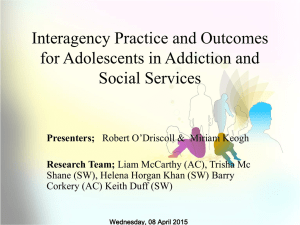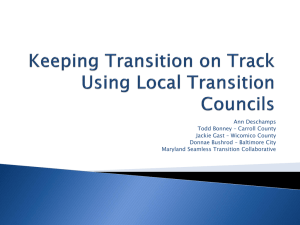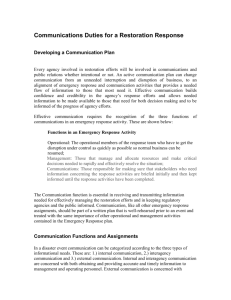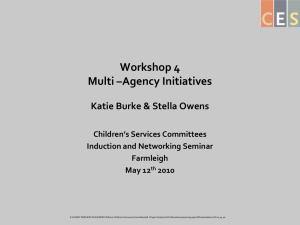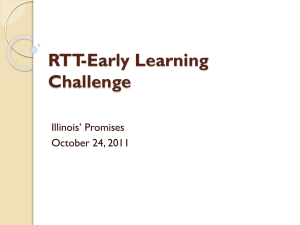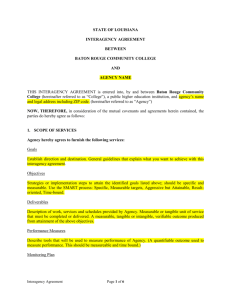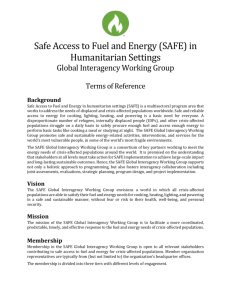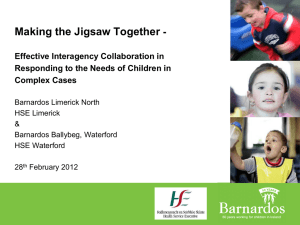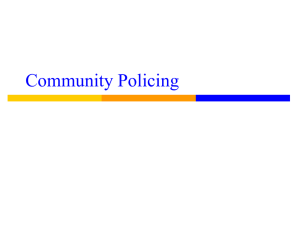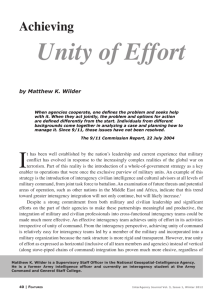- Ready By 21
advertisement
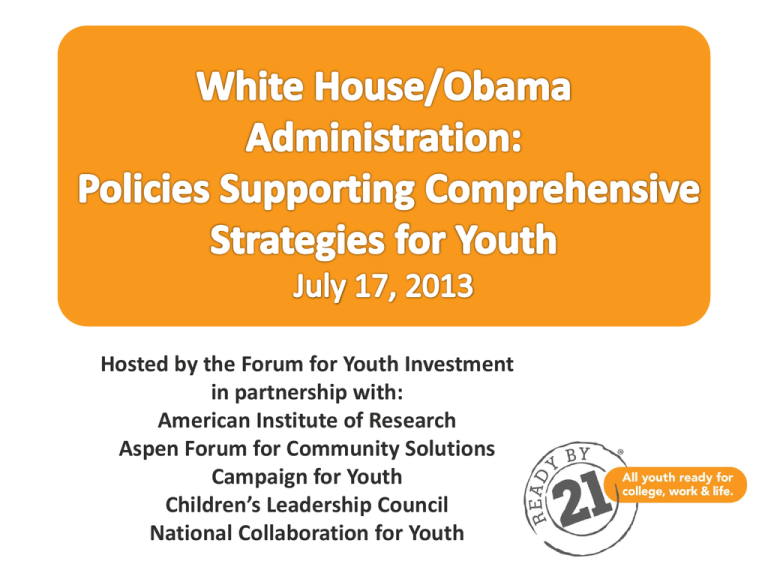
Hosted by the Forum for Youth Investment in partnership with: American Institute of Research Aspen Forum for Community Solutions Campaign for Youth Children’s Leadership Council National Collaboration for Youth Agenda • Part 1: Interagency Forum on Disconnected Youth Co-Chairs of the Interagency Forum – Kathy Stack (White House Office of Management and Budget) and Johan Uvin (Department of Education) – will discuss what was learned through the Request for Information and the next steps they plan to advance this work. • Part 2: Interagency Working Group on Youth Programs Martha Moorehouse (chair of working group) and Sarah Oberlander will present “Pathways for Youth,” the working group’s draft strategic plan for federal collaboration. 2 Interagency Forum on Disconnected Youth Co-Chairs: Kathy Stack, White House Office of Management and Budget Johan Uvin, Department of Education, Office of Vocational and Adult Education Background 2011 Presidential Memorandum on Administrative Flexibility Responses identified the following challenges to providing coordinated services to this population: Differing reporting requirements Conflicting eligibility criteria and intake processes Differing governance and advisory structures Allowable uses of funds Lack of access to quality data FY13 Federal Budget (February 2012) Request for funding and authority to implement Performance Partnership Pilots to improve outcomes for disconnected youth State and local flexibility in exchange for outcomes Interagency Forum for Disconnected Youth(IFDY) (March 2012) White House Council for Community Solutions (June 2012) Community Solutions for Opportunity Youth Final Report IFDY issues Request for Information (June 2012) 170 responses received from a broad array of stakeholders, including service providers, funders, state and local government, and youth advocates RFI Themes Need for improved access to quality data and better information sharing Interim Indicators and Shared Outcomes Measures - A need to track interim/ progress indicators - Incentivizing a long-term approach to better track outcomes Alignment of eligibility requirements, intake processes, performance measures (both interim and long term) and data collection systems Need for a multiple pathway approach addressing the full continuum prevention, intervention and re-engagement Barriers related to lack of housing stability, financial literacy and mental health services Need to target subpopulations (e.g. foster care, justice involved, homeless, youth with disabilities, GLBTQ) Importance of a long term connection with a caring adult/mentor Full youth participation/partnership in the development, implementation and evaluation of proposed pilots IFDY Strategic Goals Based on responses to the RFI and other stakeholder and agency engagement, the IFDY has developed a set of overarching strategic goals to guide its work: • Create a sustainable interagency framework for improving program outcomes via flexibility • Build evidence of what works, incorporate this evidence into program strategies, and disseminate this evidence to organizations serving disconnected youth • Engage with philanthropic organizations and other stakeholders to leverage resources, share best practices, and align public and private strategies and goals for serving disconnected youth • Convene agencies serving disconnected youth, leverage ongoing interagency work, and establish an interagency commitment to addressing problems faced by this population • Identify and pursue administrative, legislative, regulatory changes needed to test new strategies and overcome barriers to serving disconnected youth effectively FY 14 Budget – DY Overview Performance Partnership Pilot General Provision – Provides authority for Performance Partnership pilots, Labor/HHS/ED, HUD and DOJ appropriations – Establishes up to 13 Performance Partnerships pilots • No new funding, involves $130 million in existing discretionary Federal resources • Pilots could blend discretionary funds for youth-serving programs across agencies in exchange for greater accountability for results • Performance indicators , such as education and employment outcomes would be used to gauge progress $30 million is directed towards activities that will support disconnected youth and increase capacity to serve those youth – – – – $10 million – Workforce Innovation Fund (WIF), Department of Labor $10 million – Fund for the Improvement of Education (FIE), Department of Education $5 million – Disability Innovation Fund (DIF), Department of Education $5 million – Youth Data Pilot, Department of Education FY 14 Budget: Department of the Treasury $300 million one-time mandatory appropriation for a new Pay for Success (PFS) program in the Department of the Treasury. • The fund will: – Support nonprofit and other investors who finance preventive social programs when those programs prove that they can post savings to the Federal government and achieve the goal for their target population. – Ensure that taxpayers get the best possible returns for funds expended, protect government assets, and minimize losses in relation to social benefits provided. • It will accomplish this by offering credit enhancements or direct grants to support investors; intermediaries will receive a proportion of the funds saved by the government only when projects have demonstrated measurable outcomes that result in greater federal savings and programmatic efficiency. • In order to qualify, these programs will be required to utilize evidence-based approaches and provide data for program and policy evaluation. IFDY Activities • Analyzing barriers and alignment issues raised in RFI and other venues • Engaging with State and local governments, foundations, service providers, youth and other stakeholders • Exploring opportunities to increase the focus on outcomes under current law FY 14 Budget: Performance Partnership Pilots and Pay For Success Labor/HHS/ED General Provisions: http://www.whitehouse.gov/sites/default/files/omb/budget/fy2014/assets/lab. pdf (p. 792) HUD General Provisions: http://www.whitehouse.gov/sites/default/files/omb/budget/fy2014/assets/hud .pdf (p. 604) DOJ General Provisions: http://www.whitehouse.gov/sites/default/files/omb/budget/fy2014/assets/jus. pdf (p. 748) Department of the Treasury Pay For Success Provisions: http://www.whitehouse.gov/sites/default/files/omb/budget/fy2014/assets/tre. pdf (p.978) FY 14: Agency Congressional Justifications Disconnected Youth Initiative Department of Labor, ETA Overview (p. 15) – http://www.dol.gov/dol/budget/2014/PDF/CBJ-2014-V1-03.pdf Department of Education: • Innovation and Instructional Teams (p. H-114) – http://www2.ed.gov/about/overview/budget/budget14/justifications/h-iit.pdf • Rehabilitation Services and Disability Research (p. K-14) – http://www2.ed.gov/about/overview/budget/budget14/justifications/krehabilitation.pdf Department of Health and Human Services, ACF (p. 107) – https://www.acf.hhs.gov/sites/default/files/olab/fy_2014_cj_final_web.pdf Helping Federal, State, and Local Groups Support Youth: The Interagency Working Group on Youth Programs and FindYouthInfo.gov Martha Moorehouse Sarah Oberlander July 2013 Working Together to Improve Youth Outcomes We want your input! 13 Action steps to give and get input: Sign up for the newsletter on FindYouthInfo.gov during the webinar Email us at: FindYouthInfo@air.org VisitFindYouthInfo.gov and click to give input Sign up for the newsletter! Issues Youth May Be Dealing With 14 Housing Physical Health Mental health Wellness Education Delinquency Exposure to Violence at Home, in School, and in Community Substance abuse Interagency Working Group on Youth Programs Transportation Civic engagement Community connections Training and workforce readiness Employment Service learning Mentoring Disparities Safety Interagency Working Group on Youth Programs: Membership 15 U.S. Department of Agriculture U.S. Department of Commerce U.S. Department of Defense U.S. Department of Education U.S. Department of Health and Human Services (Chair) U.S. Department of Homeland Security U.S. Department of Housing and Urban Development U.S. Department of the Interior U.S. Department of Justice (Vice-Chair) U.S. Department of Labor U.S. Department of State U.S. Department of Transportation Corporation for National and Community Service Environmental Protection Agency National Science Foundation Office of National Drug Control Policy Small Business Association U.S. Social Security Administration Interagency Working Group on Youth Programs: Activities 16 Create and support a federal interagency website on youth: FindYouthInfo.gov Identify and disseminate effective strategies and practices that support youth Promote enhanced collaboration at the Federal, State, and local level Develop an overarching strategic plan for federal youth policy ** From Executive Order 13459, “Improving the Coordination and Effectiveness of Youth Programs,” and Omnibus Appropriations Act, 2009 Committee Print of the House Committee on Appropriations on H.R. 1105/Public Law 111-8, Division F Interagency Working Group on Youth Programs Sign up for our newsletter The map helps you find local partners, 17 avoid duplication, and fill gaps NEW Evidence & Innovation microsite Read Pathways for Youth – draft strategic plan and provide input A rotating spotlight section features special articles Stay in touch via LinkedIn and YouTube Cross-cutting youth topic information– federal work, collaborations, and summaries from the literature Interagency Working Group on Youth Programs Read the latest news from agencies – grant opportunities, reports, special events, and more. 19 Interagency Working Group on Youth Programs 20 Interagency Working Group on Youth Programs Map My Community enables you to enter your zip code and find federally funded youth programs in your area – so you can identify resources and gaps. 22 The new custom search of grants.gov will help you find open solicitations for youth programs. Interagency Working Group on Youth Programs 23 Interagency Working Group on Youth Programs 24 Interagency Working Group on Youth Programs Pathways: Input Process 25 Solicited input from: young people, family, State Children’s Cabinet directors, nonprofit orgs, government orgs (federal, state, and local levels), policymakers, researchers, service providers, faith-based and community-based organizations, and schools Reviewed key strategic documents related to youth Summarized the input and posted it for review Engaged federal partners who drafted and reviewed the report Interagency Working Group on Youth Programs Pathways: Goals & Initiatives 26 Goal 1: Collaboration and coordination Goal 2: Evidence-based and innovative strategies Goal 3: Youth engagement and partnerships Cross-cutting initiatives: Develop shared language for grant applications and federal documents Assess and disseminate models of collaboration Centralize and disseminate information on promising and evidence-based strategies for youth Promote data collection and long-term evaluation of policies and programs that impact youth Pathways: Next Steps 27 Action on existing activities Plan for future action Two-phase roll out plan: 1. Increase awareness and understanding 2. Deepen understanding and investment Incorporate feedback Finalize the plan Interagency Working Group on Youth Programs Read the Plan and Share Your Ideas 28 Visit FindYouthInfo.gov and give input Interagency Working Group on Youth Programs Thank you! 29 For more information: Email: FindYouthInfo@air.org VisitFindYouthInfo.gov and give input Sign up for the newsletter! Closing • If we were unable to address your question before the end of the webinar, it will be saved and provided to the federal officials so they can take it into consideration © 2008-2010 The Forum for Youth Investment. Ready by 21 and the Ready by 21 Logo are registered trademarks of the Forum for Youth Investment. 30
